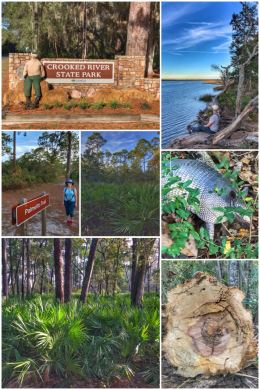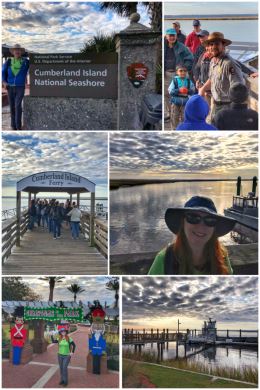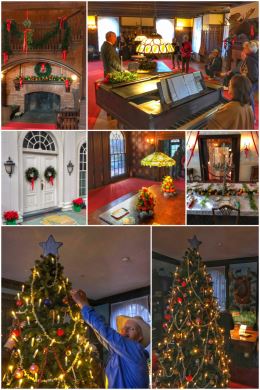
With apologies to Hoagy Carmichael and Stuart Gorrell, who wrote the 1930 song Georgia On My Mind (which is also the official state song), we briefly had Georgia on our minds during a short stop in state #43 as we continued traveling down the east coast toward a month in Florida. We will be returning to Georgia in late January as we make our final push to finish off this 2.5-year trip to the 48 states.
Georgia was founded by James Oglethorpe on Feb. 12, 1733. It was the thirteenth of the 13 original colonies. It became a state in 1788. Georgia is the largest state east of the Mississippi River. The state has been a bit unsure with its capital, having used five different cities: Savannah (1777-1785), Augusta (1786-1789), Louisville (1789-1807), Milledgeville (1807-1867), and Atlanta (1868-present). It has the second most counties in the United States with 159. (Texas has the most with 254.) Atlanta’s airport — Hartsfield-Jackson International Airport — which we are happily not traveling through, is one of the busiest in the world. St. Marys is the second oldest city in the nation — and a stepping stone for visiting Cumberland Island.
We spent our time on this quick visit to Georgia in Kingsland, located in the very southeast corner of the state (about 35 miles north of Jacksonville, FL) — where John F. Kennedy Jr. and Carolyn Jeanne Bessette stopped on their way to their September 1996 marriage on Cumberland Island.
Our first stop was Crooked River State Park, a 500-acre park located near St. Mary’s on the south bank of the Crooked River. (Cool fact: The park sits adjacent to the 16,000-acre Naval Submarine Base Kings Bay, which is home port for U.S. Navy Fleet ballistic missile nuclear submarines armed with Trident missile nuclear weapons.) The state park has a 50+ campground, along with 11 cute cottages… and, of course, picnic areas, playgrounds, and covered shelters. Our focus was hiking — and the park has about 4 miles of trails.
Our hiking adventure started on the Sempervirens Trail, Latin for “ever living,” and named for the old-growth hardwood trees you’ll discover in this easy loop trail. The trail boasts five Georgia Champion Trees: the Staggerbush Lyonia, Florida Soapberry, Myrtle Oak, Chapman Oak, and Carolina Holly… and while the trees and scenery were wonderful, the highlight for us was seeing five armadillos (one of which can be seen in the collage at the top of the blog)! From there, we hiked some of the Palmetto Trail, a 1.5-mile trail that highlights southern Georgia’s pine flatwoods, one of the most endangered ecosystems in the world, and which has several bat houses to admire along the trail. We ended our exploration with the short (only a few hundred yards) River Trail, which leads down to the Crooked River and a beautiful overlook. In total, we hiked about 2.5 miles in the park. We had considered hiking some of the 1.25-mile Boardwalk Trail, which leads to a hardwood and evergreen wetland dominated by two tree species, Loblolly Bay and Swamp Bay, but decided against it as part of the trail is closed for repairs.

Our main adventure, though, was exploring the Cumberland Island National Seashore and Cumberland Island — the largest of Georgia’s barrier islands — and accessible only by boat or ferry. By luck, there was a special Christmas event taking place on the island on the day we were visiting, so we booked the earliest ferry (9 am) to do some exploring of the island on foot in the morning. (It is best to book the ferry online or by phone, and note that the ferry only has two departures to the island: 9 am and 11:45 am.)
We arrived in St. Marys at the National Park Service visitor center at about 8 am, where we received our ferry tickets, confirmed our National Park pass for entry onto the island, and received wrist bands for the special event. We took backpacks filled with snacks, water, sunshirts, and insect repellant — as there are limited snacks on the ferry and island. We learned on the ferry that there is a Lands and Legacies auto tour available for an additional $45 cost — and which requires visitors to be on the island all day.
We had a beautiful morning for the 45-minute, 8-mile ferry ride to Sea Camp Ranger Station Dock. Cumberland Island is 18 miles long — and unless you take or rent a bicycle (or pay for the tour), you will not see much of the island without a LOT of walking/hiking — and there is camping on the island, so you could stay for multiple days and hike all over.

Cumberland Island has a fascinating history, starting with the indigenous people (for some 4,000 years). In the early 1700s, James Oglethorpe (the founder of Georgia) established a hunting lodge called Dungeness, named after a headland in Kent, England, as well as a fort at the southern point of the island called Fort William. At the north end of the island, Oglethorpe built Fort St. Andrews. In the late 1700s, Catharine Littlefield Greene (widow of Revolutionary War major general Nathanael Greene) built a huge, four-story mansion on the south end of the island that she named Dungeness, after Oglethorpe’s hunting lodge. (Interesting side fact: Catharine and her husband helped Eli Whitney develop the cotton gin in 1793.) In the late 1800s, the Carnegie family discovered the island, and Thomas Carnegie (brother of industrialist Andrew Carnegie) and his wife Lucy built a Queen Anne style mansion on the foundation of the Greene mansion — and also named it Dungeness; Lucy continued reworking the mansion until it became a 59-room Italianate mansion. (The house — the remains of which are shown in the collage — was abandoned in the 1930s and destroyed by fire in 1959.)
The family also built a guesthouse, pools, gardens and a greenhouse, support buildings, a golf course, and 40 smaller buildings to house the 200 servants who worked at the mansion. Lucy Carnegie also built and gifted three additional houses on the island for her children: Greyfield (built in 1900 and now a private inn still owned by the family); Plum Orchard (built in 1898 and donated to the National Park Service in the 1970s); and Stafford Plantation (built in 1901 and still privately owned by the Carnegie family).
The ruins are a popular spot on the island — and not just for people, but for the wild (and invasive) horses that inhabit the island. They are the only herd of feral horses on the Atlantic coast and are NOT managed in any way for food, water, veterinary care, or population control. Horses were brought to the island as early as by the Spanish, but most experts think the horses on the island are descendants from those brought by the British in the 1700s and which later became feral. In the 1800s, the Carnegie family brought in Tennessee Wakers, American Quarter Horses, Arabians, and Paso Finos to try and broaden the gene pool and strengthen the horse population. After acquiring the island and naming it part of the Cumberland Island National Seashore, the Park Service has attempted to develop a management plan for the horses, but it has been blocked from doing so. They estimate that there are between 150 and 200 horses on the island. Furthermore, the horses on Cumberland Island have a relatively short life expectancy of about 9-10 years.

We loved our hike on the southern portion of the island, hiking a little more than 5 miles before boarding another ferry for the trip up the Plum Orchard. We considered doing all of the Southend Loop Walk, but instead did an in-and-back route to make sure we did not miss the ferry. Our hike was a combination of the River Trail (.8-miles), Dungeness Trail (1.5-miles), Marsh Boardwalk, and Interdune Boardwalk… an amazing experience of various ecosystems — from Southern Live Oak forest (most covered in long beards of Spanish Moss, a member of the pineapple family that has aerial roots exposed to the humid environment, and an epophyte — meaning it is nonparasitic but supported by another plant) to marshland to sand dunes (some as high as 40 feet) and beach.
There are also numerous trails in the Plum Orchard area of the island, including: Old River Trail (1.9 miles), Yankee Paradise Trail (1.8 miles), Duckhouse Trail (2.5 miles), Kings Bottom Trail (1.4 miles), Table Point Trail (1.9 miles) and Tar Kiln Trail (1.4 miles) — some of which interconnect.
Happily, we got back in time to board the ferry to Plum Orchard (located about 7 miles north of Sea Camp). As mentioned earlier, Plum Orchard was a wedding present from Lucy Carnegie to her son George Carnegie and his bride, Margaret Thaw. The couple never had any children, but loved to entertain — and added two wings to the original house, one of which included a pool and indoor squash court. Plum Orchard — with a total of 22,000-square feet — served as the couple’s primary winter residence until George’s passing in 1921.

While Plum Orchard is open daily for tours as part of the the Lands and Legacies Tours, once a year in early December, there is a special holiday event. The Plum Orchard Christmas Tour is a fun afternoon event that helps with getting into the holiday spirit — and with just a small additional fee ($10 per person). Note: It is best to make reservations ahead of time to guarantee a spot on the ferry.
During the event, the mansion gets decorated for the holiday season, with tours conducted by volunteers and staff dressed in period clothing discussing the history of the mansion as well as Christmas traditions from the period.
One of the volunteers decked out in her holiday attire boarded the special ferry at Sea Camp and chatted with many of the passengers while in character — talking about “the great Christmas party taking place at my aunt’s house.” She later sat down with us and talked (not in character) about how she loves splitting time between Georgia and Minnesota. She was still relatively new at the holiday event, but was looking forward to contributing.
The tour begins with the Park Service putting people in small groups — each of which starts in a different station in the mansion (side porch, front door, kitchen, swimming pool, etc.). We loved the tour, though some of the volunteers went a bit overboard in the details they provided. Two highlights stand out from the tour — the Christmas decorations and a high-school choir singing Christmas carols. The Park Service also needs to get a bit more organized with the tour, as it started kind of badly… but once the tour started, things settled down… until the end, when it stopped a bit abruptly while we were in our last station and were told we needed to get down to the ferry quickly.
This fairly brief stop in Georgia was much more fun than we expected — and we look forward to exploring more of the state (including a long visit to Atlanta) in 2020!
For now, though, it is time for continuing on into Florida for the rest of 2019.
